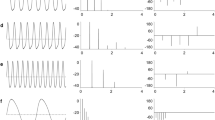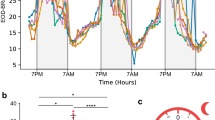Summary
-
1.
The gymnotid, Gymnorhamphichthys hypostomus, (sandfish) exhibits in nature well marked activity cycles which are accompanied by substantial changes in the frequency of discharges from its electric organ.
-
2.
During the day the sandfish is buried in the sand and the discharge frequency is low (10 to 15/sec): at night the fish is freely swimming and the frequency is high (65 to 100/sec).
-
3.
The sharp rise in discharge frequency, which occurs when the fish emerges from the sand, provides a useful reference point in determining the phase of the rhythm. This sharp rise is preceded by a slight and very gradual pre-emergence rise in frequency.
-
4.
The periodicity of frequency changes persists in continuous dim light with a period which is often significantly different from exactly 24 hours and must therefore be considered an endogenous rhythm.
-
5.
Light appears to be the effective entraining agent.
-
6.
The basic discharge rate of the undisturbed fish appears to be determined by the endogenous rhythm, but the frequency at any one time can be markedly affected by external stimuli. The endogenous rhythm can overrule the indirect inhibitory effects of a light stimulus.
-
7.
Light per se has little or no direct influence on the discharge rate; e.g. the fish continues to be active and to discharge at high frequency for prolonged periods in the presence of light if no sand is available.
Zusammenfassung
-
1.
Der Gymnotide Gymnorhamphichthys hypostomus (Sandfisch) hat in seinem natürlichen Biotop einen ausgesprochenen Aktivitätszyklus, mit dem erhebliche Frequenzänderungen der Entladungen des elektrischen Organs einhergehen.
-
2.
Am Tage ist der Sandfisch im Sand eingegraben und die Entladungsfrequenz ist niedrig (10 bis 15/sec); nachts schwimmt der Fisch umher und die Entladungsfrequenz ist hoch (65 bis 100/sec).
-
3.
Der scharfe Anstieg der Entladungsfrequenz, der beim Verlassen des Sandes auftritt, gibt einen brauchbaren Bezugspunkt für die Bestimmung der Phase des Aktivitätsrhythmus ab. Diesem scharfen Anstieg geht eine geringe und sehr langsame Frequenzzunahme vor dem Auftauchen aus dem Sand voraus.
-
4.
Die Periodizität der Frequenzänderungen bleibt in kontinuierlichem Dämmerlicht erhalten; die Periode ist oft signifikant verschieden von 24 Stunden und beruht daher auf einem endogenen Rhythmus.
-
5.
Licht scheint der wesentliche Zeitgeber zu sein.
-
6.
Die Grundfrequenz des ungestörten Fisches scheint durch einen endogenen Rhythmus bestimmt zu sein; jedoch kann die Entladungsfrequenz jederzeit durch äußere Reize wesentlich verändert werden. Der endogene Rhythmus kann sich gegenüber den indirekten hemmenden Wirkungen eines Lichtreizes durchsetzen.
-
7.
Licht an sich hat geringen oder keinen direkten Einfluß auf die Entladungsfrequenz; z.B. bleibt der Fisch bei Belichtung mit hoher Entladungsfrequenz lange Zeit aktiv, wenn im Aquarium kein Sand ist, in dem er sich eingraben kann.
Similar content being viewed by others
References
Aschoff, J.: Tierische Periodik unter dem Einfluß von Zeitgebern. Z. Tierpsychol. 15, 1–30 (1958).
Comparative physiology — diurnal rhythms. Ann Rev. Physiol. 25, 581–601 (1963).
Bünning, E.: Die physiologische Uhr, 2. Aufl. Berlin-Göttingen-Heidelberg: Springer 1963.
Carlander, K. D., and R. E. Cleary: The daily activity pattern of some freshwater fish. Amer. Midld Naturalist 41, 447–452 (1949).
Coursey, P. J. de: Daily light sensitivity in a rodent. Science 131, 33–35 (1960a).
: Phase control of activity in a rodent. Cold Spr. Harb. Symp. quant. Biol. 25, 49–55 (1960b).
Coursey, P. J. de: Effect of light on the circadian activity of the flying squirrel, Glaucomys volans. Z. vergl. Physiol. 44, 331–354 (1961).
: Function of a light response rhythm in hamsters, J. cell. comp. Physiol. 63, 189–196 (1964).
Davis, R. E.: Daily “predawn” peak of locomotion in fish. Anim. Behav. 12, 272–283 (1964).
Eigenmann, C. H.: The freshwater fishes of British Guiana. Mem. Carnegie Mus. 5, 436–437 (1912).
Fowler, H. W.: Os peixes de água doce do Brasil, part 3. Arch. Zool. estado São Paulo, 6, 436 (1951).
Halberg, F.: Physiologic 24 hour periodicity; general and procedural considerations with reference to the adrenal cycle. Z. Vitamin-, Hormon- u. Fermentforsch. 10, 225–296 (1959).
Harder, W., A. Schief, u. H. Uhlemann: Zur Funktion des elektrischen Organs von Gnathonemus petersii (Gthr. 1862) (Mormyriformes, Teleostei). Z. vergl. Physiol. 48, 302–331 (1964).
Harker, J. E.: The physiology of diurnal rhythms. Cambridge: Cambridge University Press 1964.
Jones, F. R H.: Photo-kinesis in the ammocoete larva of the brook lamprey. J. exp. Biol. 32, 492–503 (1955).
: The behaviour of minnows in relation to light intensity. J. exp. Biol. 33, 271–281 (1956).
Kruuk, H.: Diurnal periodicity in the activity of the common sole, Solea vulgaris Quensel. Netherl. J. Sea Res. 2, 1–28 (1963).
Lissmann, H. W.: On the function and evolution of electric organs in fish. J. exp. Biol. 35, 156–191 (1958).
: Ecological studies on gymnotids. Bioelectrogenesis (Ed. C. Chagas and A. Paes de Carvalho), p. 215–226. Amsterdam and London: Elsevier Publ. Co. 1961.
Pittendrigh, C. S.: Circadian rhythms and the circadian organisation of living systems. Cold Spring Harb. Symp. Quant. Biol. 25, 159–184 (1960).
, and D. H. Minis: The entrainment of circadian oscillations by light and their role as photoperiodic clocks. Amer. Naturalist 98, 261–294 (1964).
Spencer, W. P.: Diurnal activity rhythms in freshwater fishes. Ohio J. Sci. 39, 119–132 (1939).
Webb, H. M., A. F. Brown, M. F. Bennett, J. Shriner, and R. A. Brown: An alteration of the persistent daily rhythm of the fiddler crab. Anat. Rec. 125, 615 (1956).
Wikgren, J.: Daily activity pattern of the burbot. Mem. Soc. pro Fauna et Flora fennica 31, 91–95 (1955).
Author information
Authors and Affiliations
Additional information
Supported by Grant 615-64 of the U. S. Airforce, Office of Scientific Research to Dr. T. H. Bullock and Contract NR 301-790 of the U. S. Navy, Office of Naval Research.
We wish to express our gratitude particularly to Dr. Dalcy de Oliveira Albuquerque of the Museu Goeldi, Belém, Brazil, for providing facilities during the early part of the study, to Dr. Lawrence Kruger for making available to us space and all equipment, to Dr. Thomas M. Heric for his most valuable help in setting up the recording apparatus and to Ken Fogelberg and Lanny Lampl for their efficient assistance in data processing.
Rights and permissions
About this article
Cite this article
Lissmann, H.W., Schwassmann, H.O. Activity rhythm of an electric fish, Gymnorhamphichthys hypostomus, ellis. Z. Vergl. Physiol. 51, 153–171 (1965). https://doi.org/10.1007/BF00299291
Received:
Issue Date:
DOI: https://doi.org/10.1007/BF00299291




